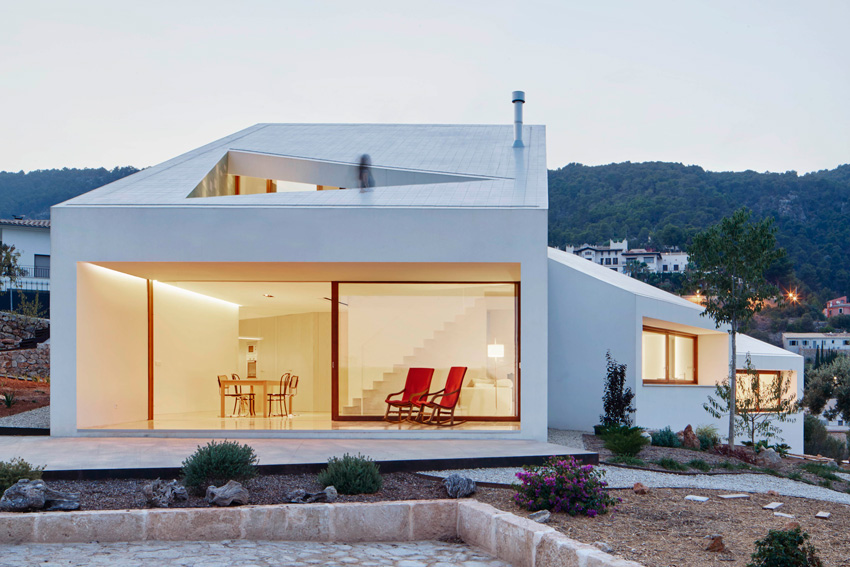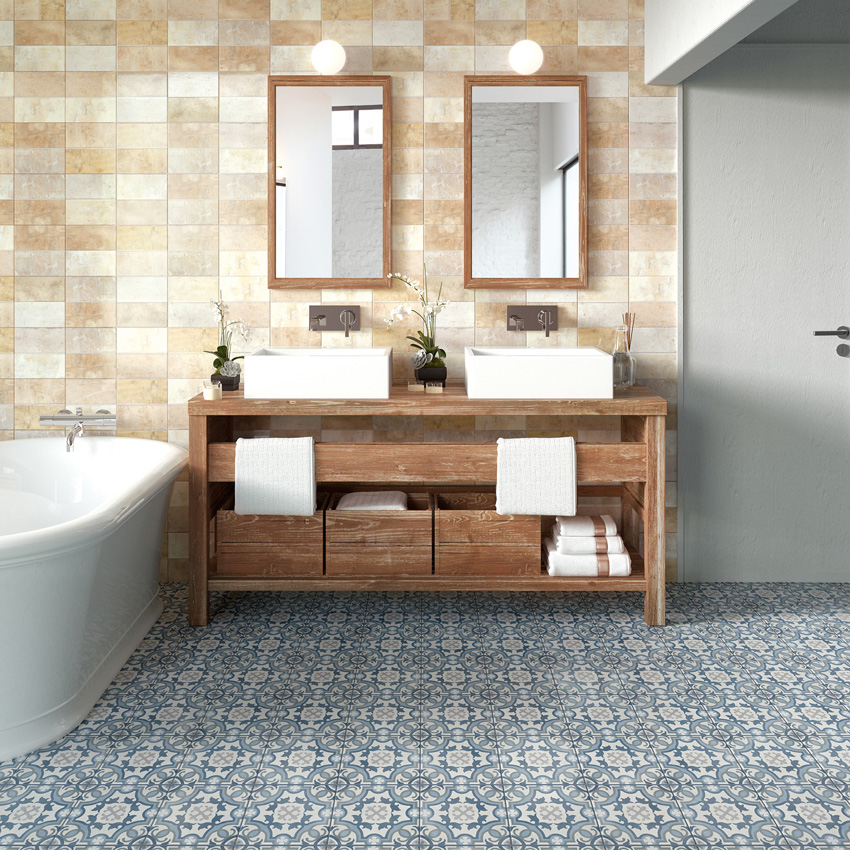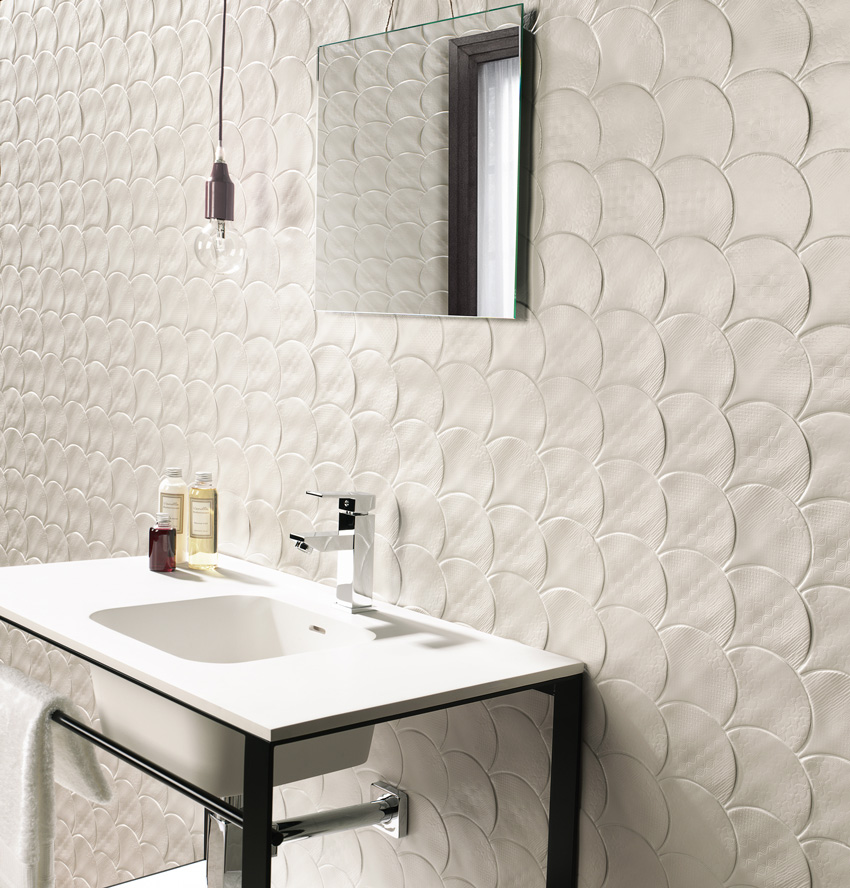Innovation and Industry: Ceramic’s Sustainable Story
A Healthy Finish
There is an increasingly widespread initiative to design buildings with interior environments that make people healthier. The International WELL Institute was launched in 2013 with the goal of focusing on criteria that promote occupant well-being. The WELL standard measures building performance based on physiological human behavior. It is organized under seven concepts key to the design of buildings, where humans spend over 90 percent of each day. These concepts include air, water, nourishment, light, fitness, and comfort. The WELL program is administered through IWBI’s collaboration with Green Business Certification Inc. (GBCI), which also administers LEED certification among others.11
Designers are encouraged to consider the various systems in the human body. For example, to avoid aggravating the cardiovascular, respiratory, immune, integumentary, and endocrine systems, exposure to pollutants, including chemical, such as VOCs, and organic, such as allergens, bacteria, and mold, should be reduced. The attributes of ceramic tile that are compliant with healthy finishes promoting the criteria of WELL include those that improve indoor air quality, such as mold resistance.
A new tile product even provides bactericidal properties and removes any bacteria on its surface. The bactericidal properties of this product are due to the use of silver nanoparticles that are integrated during the production process of the porcelain stoneware before it is baked. The combination of silver nanoparticles and humidity releases silver ions. The silver ions stop the microbial metabolism, and in a short amount of time, the bacteria disappear completely. This new tile is being used in hospitals, senior centers, clinics, restaurants, and in the food industry.12

Photo courtesy of Tile of Spain
Ceramic tile was used to meet Passive Haus guidelines in this award-winning home in Spain.
Top 10 Reasons to Choose Sustainable Tile
When developing a top-10 list of criteria for materials that promote health, support environmental initiatives, and are economically feasible, common attributes like durability, maintenance requirements, and performance characteristics should be considered. Ceramic tile is a good choice as an aesthetic as well as sustainable building material. The top 10 reasons to use ceramic tile are:
- Its value is amortized over time.
- It is inhospitable to dust mites, germs, and bacteria. Tile is inorganic and will not contain or harbor any food source for organic allergens or organisms.
- It is durable.
- It is water resistant.
- It is low maintenance.
- It is fire resistant.
- It is fade resistant.
- It is a natural material with transparent LCA values.
- It is versatile and can be used for floor, wall, countertop, interior, and exterior applications in all climates.
- It is aesthetically pleasing.
These are just some of the reasons to select ceramic products with even more choices for interior and exterior applications.

Photo courtesy of Tile of Spain
Designers have more aesthetic choices when specifying tiles that meet universal design recommendations of 0.42 DCOF.
Design for All
Human-centered design, or universal design, is another aspect of the design of a building for the well-being of occupants. Meeting the regulations of the American Disabilities Act (ADA) is a legal requirement to design buildings that are safe for all occupants, particularly those with disabilities. There is no longer a minimum tolerance threshold for ADA standards for slip resistance. Design professionals can be confused as to how to specify flooring with sufficient traction in wet environments. The coefficient of friction (COF) is the common standard for a slippery floor. A zero COF means that a wet floor is very slippery, while any number higher than one might mean that the occupant was walking in sand.
In 2012, ASTM C1028 was no longer used to test the slip resistance of tile. This standard was based on the static coefficient of friction (SCOF). Although the standard was changed, many architects are still specifying commercial floors with a slip resistance of 0.60 SCOF. The new standard of measurement is the dynamic coefficient of friction (DCOF). This new test better reflects real-life situations on wet tile. New guidelines recommend that designers specify ceramic tiles that meet a minimum of 0.42 DCOF value as measured by the BOT 3000 testing apparatus. Using this testing machine, even existing floors can be measured for safety during renovations, and periodic tests in situ can address the ongoing performance or longevity of a slip-resistant finish.
This change occurred due to research at the University of Wuppertal in Germany (known worldwide for its traction studies). It studied human subjects walking on force plates to study the relationship between the tangential force and the vertical force needed for reliable traction. The German researchers considered many different slippery conditions, different ways people could move on a surface, and accident statistics over many years. This led to the recommendation of a minimum wet DCOF value of 0.42 for flooring to the German national insurance body. In various studies at the TCNA, including a study of more than 300 tile surfaces, TCNA researchers found that 0.60 wet SCOF correlated on average with 0.38 wet DCOF.13
Considering both the TCNA research and the years of research in Europe, the ANSI A108 Accredited Standards Committee decided to adopt the German recommendation and include in ANSI A137.1–2012 a required minimum threshold of 0.42 (per the DCOF AcuTest) for level interior spaces expected to be walked upon when wet. By requiring a value higher than 0.38, the new standard provides an additional measure of safety over the widely used ASTM C1028 wet SCOF value of 0.60.
The DCOF of installed tiles can change over time as a result of wear and surface contaminants. In addition to regular cleaning, deep cleaning and traction-enhancing maintenance may be needed periodically to maintain DCOF values. With the portability and ease of the DCOF AcuTest, periodic evaluation of flooring surfaces is now easily accomplished. In this method, the BOT 3000, an automated and portable device, is used with a unique rubber sensor and slightly soapy water (or more precisely, 0.05 percent sodium lauryl sulfate solution) to measure the dynamic friction of installed tiles.
Where floor tiles have a DCOF lower than 0.42, care must be exercised to ensure the tiles are not walked on while wet. In addition to choosing flooring surfaces with sufficient traction, designers should provide adequate lighting and design spaces that allow for suitable drainage to reduce slip/fall accidents. Proper footwear and shoe materials can also greatly improve traction and should be considered in any campaign to reduce slips and falls on wet surfaces.

Photo courtesy of Tile of Spain
New sleek ceramic countertops provide a safe nonconductive surface in kitchens where heat and cold can cause problems.

Photo courtesy of Tile of Spain
Thinner and larger tile surface materials are available for use on interior and exterior walls.
Innovative Tile
Innovative tile products are increasing the market for this versatile material. In addition to innovations as described in ceramics made from recycled foundry material and ceramics with antibacterial properties, engineering advancements in ceramics have added new products to the market. Thinner, thicker, and larger tile surface materials are available for use in a variety of commercial applications. These include thicker exterior pavers for sand or grass-set installations, large surface countertops, and exterior panel cladding. From countertops to pavers, there are even more choices for architects to select ceramic tile to achieve sustainable environmental benefits.
Nonconductive Countertops
Ceramic countertops provide a safe nonconductive surface in kitchens where heat and cold can cause problems. However, grouted ceramic tiles can provide an uneven and hard-to-clean counter surface. New large surfaces made from gauged porcelain panels are now available for use in food preparation areas. These slim panels are generally made in thicknesses of 12 millimeters or 1/2 inch for stability in standard cabinetry installations. They require minimal support with no need for tile joints. By using the high thermal mass and low conductivity of ceramics, radiant heating zones can be installed beneath these counters for uses like plate warming, defrosting, etc. They can be installed to mimic any other stone or artificial laminate. Furthermore, these new tile countertops can be fabricated like any natural stone and often in formats larger than available in the natural materials. Slabs up to 5.5 feet by 11 feet are available for horizontal applications.
Durable Exterior Paving
For use in all terrains, 1/2-inch-thick porcelain pavers can be used outside. On grass, cement, sand, or gravel, these pavers provide an alternative to cement pavers with the benefit of a much larger array of surface designs. By using adjustable supports, these tiles can be part of a raised flooring system used on decks, stairs, and pool areas where all slopes, waterproofing, and drainage systems can be hidden below grade. Choosing a porcelain exterior tile takes advantage of all of the benefits of this ceramic material. These tiles are durable, easy to maintain, and thermally stable. Selection of lighter colored tiles with a high solar reflective index (SRI) can reduce the urban heat island effect when used in exterior hardscaping. They can meet the criteria for flooring that meets universal design recommendations in an exterior application.
Fade-Resistant Porcelain Panels
Many Mid-century Modern designers used glazed ceramic tiles as a design element. The General Motors Technology Center, considered one of the most important works of architect Eero Saarinen, is a good example of how the use of color adds excitement to a corporate campus. Continued use of glazed brick or glazed cement created a new aesthetic. Glazed cement products are heavy, composite materials with a ceramic facing. These products are required to meet strict guidelines for fading and chemical resistance. Lightweight, gauged-porcelain, all-ceramic panels are now available for slabs and cladding. These products will not fade and are moisture, chemical, and stain resistant.
To support this growing industry, ANSI released two new standards after years of cross-disciplinary collaboration and research that define the performance of both thin pavers and wall products. These standards are ANSI A137.3: The American National Standard Specifications for Gauged Porcelain Tiles and Gauged Porcelain Tile Panels/Slabs, and its companion, ANSI A108.19: Interior Installation of Gauged Porcelain Tiles and Gauged Porcelain Tile Panels/Slabs by the Thin-Bed Method bonded with Modified Dry-Set Cement Mortar or Improved Modified Dry-Set Cement Mortar. This thin-tile standard covers a range of the thickness or gauge of these panels for wall applications from 3.5 to 4.9 millimeters (1/8 inch to 3/16 inch) and for wall and floor applications from 5 to 6.5 millimeters (3/16 inch to 1/4 inch).14
A Sustainable Future
The story of new ceramic materials provides a lesson in how an industry can come together to create a new sustainable future. In conjunction with design professionals, industry leaders, university researchers, and governmental incentives, the ceramic industry is expanding to make buildings better for all occupants as well as the environment. They are providing leadership in the path toward responsible environmental leadership.
End Notes
1“Buildings.” European Commission. Web. 14 May 2017. https://ec.europa.eu/energy/en/topics/energy-efficiency/buildings.
2The Drive Toward Healthier Buildings 2016: Tactical Intelligence to Transform Building Design and Construction. SmartMarket Reports. Dodge Data & Analytics. Web. 7 June 2017. www.engineering.com/Portals/0/Stories/14871/Drive_Toward_Healthier_Buildings_2016.pdf.
3“Ceramic Tiles Market Size By Product (Floor Tiles, Wall Tiles), By Application (Residential Replacement, Commercial, New Residential), Industry Analysis Report, Regional Outlook (U.S., Canada, Germany, UK, France, Spain, Italy, China, India, Japan, Australia, Indonesia, Malaysia, Brazil, Mexico, South Africa, GCC), Growth Potential, Price Trends, Competitive Market Share & Forecast, 2013–2024.” Global Market Insights. September 2016. Web. 15 May 2017. www.gminsights.com/industry-analysis/ceramic-tiles-market.
4Benveniste, G. et all. “Sectoral Life Cycle Analysis of Ceramic Tile.” Web. 15 May, 2017 www.pharosproject.net/uploads/files/sources/1828/1395065078.pdf.
5“Summary: Agricultural carbonic fertilization with ceramic industry greenhouse gases emissions.” Fertilife. LIFE and Climate Change Mitigation. European Commission. Web. 15 May 2017. www.fertilife-project.eu/project/summary/.
6“The Goal: Zero-waste in ceramic tile manufacture.” LIFECERAM. Web. 15 May 2017. www.lifeceram.eu/.
7“Sustainability in Spanish Tile Production: The LIFE Foundrytile Project.” Tile of Spain. 10 May 2017. Web. 15 May 2017. www.tileofspainusa.com/sustainability-in-spanish-tile-production-the-life-foundrytile-project/#sthash.XjMlTuRa.4frxNGOC.dpbs.
8“The LIFE Programme.” European Commission. 14 March 2017. Web. 15 May 2017. ec.europa.eu/environment/life/about/.
9“Building product disclosure and optimization – environmental product declarations.” LEEDv4, U.S. Green Building Council. Web. 15 May 2017. www.usgbc.org/credits/new-construction-core-and-shell-schools-new-construction-retail-new-construction-healthca-22.
10Floor Coverings Comparison: Costs for 17 Surfaces. Tile Council of North America. 2006. Web. 17 May 2017. www.tilethenaturalchoice.com/pdf/FloorCoveringComparison.pdf.
11“Our Standard.” International WELL Building Institute. Web. 17 May 2017. https://www.wellcertified.com/en/our-standard.
12Bactericidal Ceramic – Biostop.” Rosagres. Web. 17 May 2017. rosagres.com/en/bactericidal-ceramic-biostop/.
13“TCNA Technical Bulletin 2013: Coefficient of Friction and the DCOF AcuTest.” Tile Council of North America. August 2013. Web. 1 June 2017. www.tcnatile.com/images/pdfs/DCOFBrochure_Aug2013_Comp.pdf.
14“Industry Collaboration, Exhaustive Research Results in New ANSI Gauged Porcelain/”Thin Tile” Standards Debuting at Coverings.” Tile Council of North America. 5 April 2017. Web. 18 May 2017. www.tcnatile.com/component/content/index.php?option=com_content&view=article&id=301.
Celeste Allen Novak, FAIA, LEED AP BD+C, is an architect, writer, and planning consultant in Michigan. Her firm concentrates on sustainability, universal design, and rainwater collection systems.

|
A strong global leader, Tile of Spain is the international brand representing 125 ceramic tile manufacturers belonging to the Spanish Ceramic Tile Manufacturers’ Association (ASCER). Its objective is to support and promote Spain’s tile manufacturers and industry worldwide. http://www.tileofspainusa.com/ |








